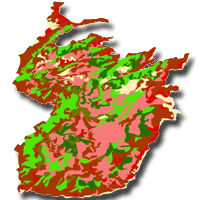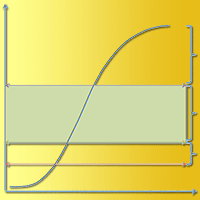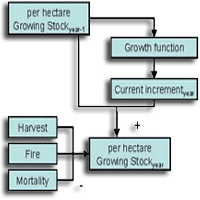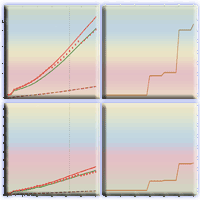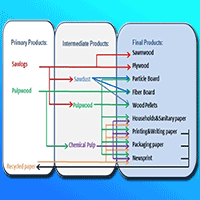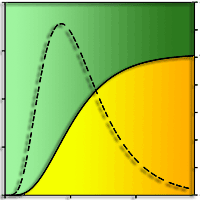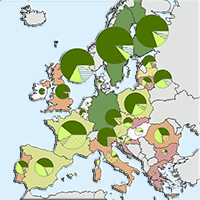
Outlook of the European forest-based sector: forest growth, harvest demand, wood-product markets, and forest carbon dynamics implications
Ragnar Jonsson (1) , Viorel NB Blujdea (2), Giulia Fiorese (1), Roberto Pilli (1), Francesca Rinaldi (1), Claudia Baranzelli (3), Andrea Camia (1)
iForest - Biogeosciences and Forestry, Volume 11, Issue 2, Pages 315-328 (2018)
doi: https://doi.org/10.3832/ifor2636-011
Published: Apr 18, 2018 - Copyright © 2018 SISEF
Research Articles
Abstract
A comprehensive assessment of European forest-based biomass harvest potentials, their future utilization and implications on international wood product markets and forest carbon dynamics requires the capability to model forest resource development as well as global markets for wood-based commodities with sufficient geographical and product detail and, most importantly, their interactions. To this aim, we apply a model framework fully integrating a European forest resource model and a global economic forest sector model. In a business-as-usual (BaU) scenario, European Union harvests increase seven percent by 2030 compared to past levels (485 million m3 on 2000-2012 average and 517 million m3 in 2030). The subsequent annual carbon stock change is a ten percent reduction by 2030 compared to 2000-2012 average (equal to 119.3 Tg C yr-1), corresponding to decreasing carbon-dioxide removal by the European forests. A second, high mobilization scenario (HM), characterized by the full utilization of the potential wood supply and a doubling of EU wood pellets consumption, was designed to explore potential impacts on forest carbon dynamics and international wood product markets under intensive exploitation of biomass resources. In the HM scenario, harvest increases by 55% (754 million m3 in 2030) compared to the BaU scenario. Fuelwood accounts for this increase in harvest levels as overall competition effects from increased wood pellets consumption outweighs synergies for material uses of wood, resulting in slightly reduced harvests of industrial roundwood. As expected, this increasing harvest level would significantly impair carbon-dioxide forest sequestration from the atmosphere in the medium term (-83% in 2030, compared to 2000-2012 average).
Keywords
Biomass, Carbon Stock Change, Forest, Fuelwood, Harvest, Wood-based Products
Authors’ Info
Authors’ address
Giulia Fiorese
Roberto Pilli
Francesca Rinaldi
Andrea Camia
European Commission, Joint Research Centre (JRC), Directorate D: Sustainable Resources, Bioeconomy Unit, v. E. Fermi 2749, I-21027 Ispra, Varese (Italy)
Faculty of Silviculture and Forest Engineering, Transilvania University of Brasov, Sirul Beethoven 1, 500123 Brasov (Romania)
European Commission, Joint Research Centre (JRC), Directorate B: Growth & Innovation, Territorial Development Unit, v. E. Fermi 2749, I-21027 Ispra, Varese (Italy)
Corresponding author
Paper Info
Citation
Jonsson R, Blujdea VNB, Fiorese G, Pilli R, Rinaldi F, Baranzelli C, Camia A (2018). Outlook of the European forest-based sector: forest growth, harvest demand, wood-product markets, and forest carbon dynamics implications. iForest 11: 315-328. - doi: 10.3832/ifor2636-011
Academic Editor
Piermaria Corona
Paper history
Received: Sep 19, 2017
Accepted: Mar 21, 2018
First online: Apr 18, 2018
Publication Date: Apr 30, 2018
Publication Time: 0.93 months
Copyright Information
© SISEF - The Italian Society of Silviculture and Forest Ecology 2018
Open Access
This article is distributed under the terms of the Creative Commons Attribution-Non Commercial 4.0 International (https://creativecommons.org/licenses/by-nc/4.0/), which permits unrestricted use, distribution, and reproduction in any medium, provided you give appropriate credit to the original author(s) and the source, provide a link to the Creative Commons license, and indicate if changes were made.
Web Metrics
Breakdown by View Type
Article Usage
Total Article Views: 54534
(from publication date up to now)
Breakdown by View Type
HTML Page Views: 41305
Abstract Page Views: 7028
PDF Downloads: 5268
Citation/Reference Downloads: 31
XML Downloads: 902
Web Metrics
Days since publication: 2799
Overall contacts: 54534
Avg. contacts per week: 136.38
Citation Metrics
Article Citations
Article citations are based on data periodically collected from the Clarivate Web of Science web site
(last update: Mar 2025)
Total number of cites (since 2018): 18
Average cites per year: 2.25
Publication Metrics
by Dimensions ©
Articles citing this article
List of the papers citing this article based on CrossRef Cited-by.
References
The Reference Scenario in the LUISA platform - Updated configuration 2014, towards a common baseline scenario for EC impact assessment procedures. EUR 27019, Publications Office of the European Union, Luxembourg, pp. 45.
Gscholar
How much bioenergy can Europe produce without harming the environment? EEA report 7, European Environment Agency, Copenhagen, Denmark, pp. 67.
Gscholar
Environmentally compatible bio-energy potential from European forests. European Environment Agency, Copenhagen, Denmark, pp. 39.
Gscholar
A new EU forest strategy: for forests and the forest-based sector. Communication from the Commission to the European Parliament, the Council, the European Economic and Social Committee and the Committee of the regions, Brussels, Belgium, pp. 17.
Gscholar
A policy framework for climate and energy in the period from 2020 to 2030. Communication from the Commission to the European Parliament, the Council, the European Economic and Social Committee and the Committee of the regions, Brussels, Belgium, pp. 18.
Gscholar
EU Reference Scenario 2016. Energy, transport and GHG emissions trends to 2050. European Union, Luxembourg, pp. 221.
Gscholar
Environmental implications of increased reliance of the EU on biomass from the South East US. Publications Office of the European Union, Luxembourg, pp. 357.
Gscholar
Analysis and modelling of energy, transport and climate change scenarios: future GHG emission from agriculture and forestry. JRC Technical Reports, European Commission, Ispra, Italy, pp. 174.
Gscholar
Forest product conversion factors for the UNECE region. Geneva Timber and Forest Discussion Paper 49, UNECE/FAO, Geneva, Switzerland, pp. 34.
Gscholar
Study on impacts on resource efficiency of future EU demand for bioenergy. Task 3: Modelling of impacts of an increased EU bioenergy demand on biomass production, use and prices. Publication Office of the European Union, Luxembourg, pp. 43.
Online | Gscholar
Econometric modelling and projections of wood products demand, supply and trade in Europe, Geneva Timber and Forest Discussion Paper 59, UNECE/FAO, Geneva, Switzerland, pp. 192.
Gscholar
The global forest sector model EFI-GTM - The Model Structure, EFI Internal Report 15, European Forest Institute, Joensuu, Finland, pp. 24.
Gscholar
ClimWood2030 - Climate benefits of material substitution by forest biomass and harvested wood products: perspective 2030. Final report, Thünen Report no. 42, Braunschweig, Germany, pp. 148.
Gscholar
Industrial wood residues. In: “EUwood - Methodology Report” (Mantau U ed). Hamburg University, Hamburg, Germany, pp. 124-145.
Gscholar
The European forest sector outlook study II. Geneva Timber and Forest Study Paper no. 28, UNECE/FAO, Geneva, Switzerland, pp. 111.
Gscholar
Scenarios: the art of strategic conversation. Wiley, New York, USA, pp. 382.
Gscholar


